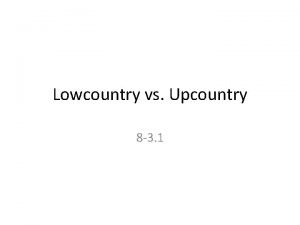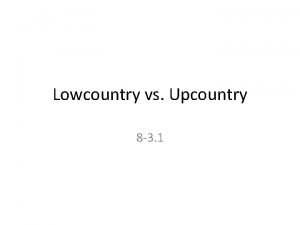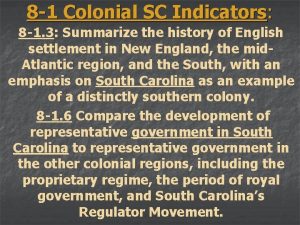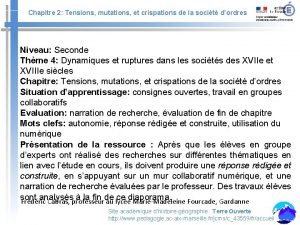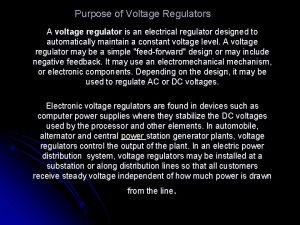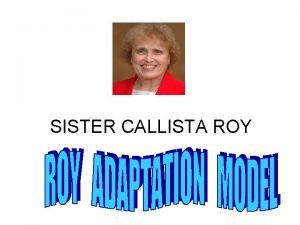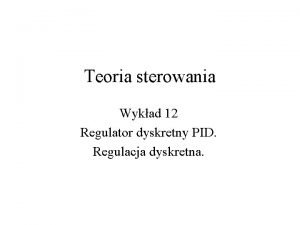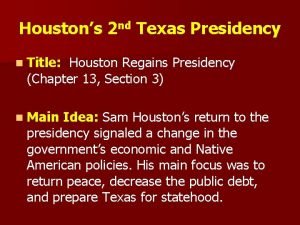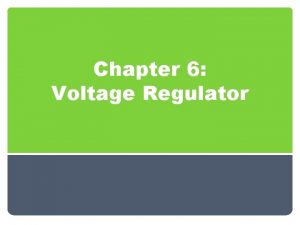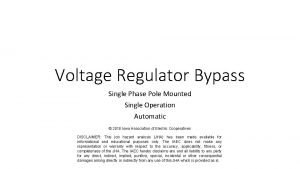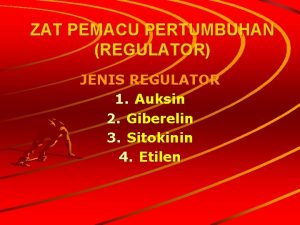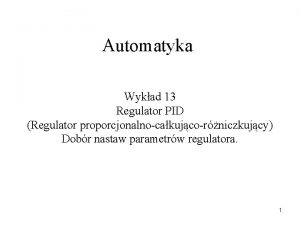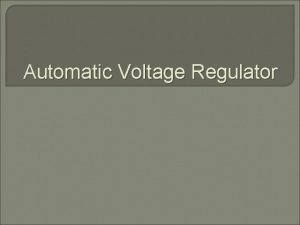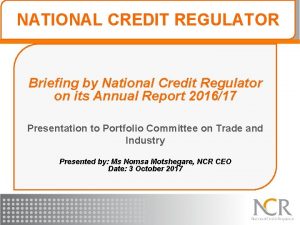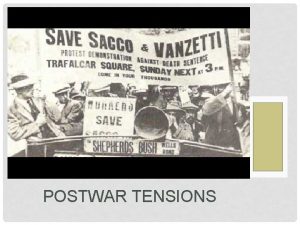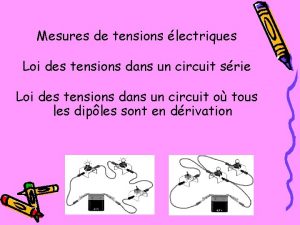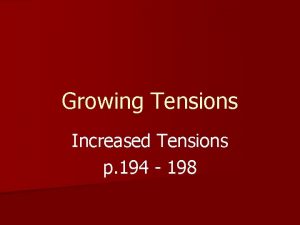Lowcountry vs Upcountry 8 3 1 Tensions Regulator

















- Slides: 17

Lowcountry vs. Upcountry 8 -3. 1

Tensions • Regulator movement • Revolutionary war- Lowcountry Patriots fought backcountry Loyalists. • Political representation

I. Upcountry A. Who and where? 1. northwestern part of the state 2. home to the Cherokees 1 st 3. 1 st whites were traders and woodsmen 4. viewed as uncivilized by the Lowcountry elite 5. tended to be Loyalists during the Revolution

I. Upcountry B. Subsistence farmers 1. Growing enough food to survive 2. Few owned slaves 3. Tended to be poor C. Revolution hurt Upcountry 1. British destroyed farms, took livestock

I. Upcountry D. Politically Unequal 1. Higher white population 2. Not represented equally 3. Far away from the capital of Charleston 4. In 1786, capital was moved to Columbia a) Made it closer and easier b) Helped with the tension a little bit

I. Upcountry E. Slavery 1. Upcountry didn’t support it 2. Lowcountry didn’t want to give up political power 3. Cotton gin made cotton a money maker for everyone 4. Upcountry began to use slaves to grow cotton 5. Compromise of 1808 reapportionment based on white population and property (land slaves)

II. Lowcountry A. Who and where? 1. area around Charleston and along the Atlantic coast 2. 1 st area to be settled 3. plantation owners growing rich from rice and indigo 4. tended to be Patriots during the Revolution

II. Lowcountry B. plantations with lots of slave labor 1. tended to be very rich C. Revolution hurt Lowcountry 1. British destroyed property, took slaves and livestock

D. Economic Problems 1. made most of their money using mercantilism 2. when war ended, England didn’t buy Lowcountry crops as much a) subsidies stop too 3. owed lots of money to England 4. US & SC gov’t couldn’t pay for stuff they “borrowed” for the war 5. poor crops made it worse until cotton came along II. Lowcountry

II. Lowcountry E. Unequal power 1. Charleston was capital and made it easy for elite 2. Had far greater representation in gov’t 3. Once Upcountry agreed with slavery, Lowcountry gave more power to them (Compromise of 1808)

III. Compromise of 1808 • Lowcountry resisted giving the Upcountry more representation in the legislature • They feared the Upcountry would not support Slavery • The invention of the cotton gin made cotton a viable cash crop in the upcountry. • As a result, the upcountry now needed slave labor

Compromise of 1808 • As the number of slaves increased in the upcountry, the willingness of the Lowcountry to share power increased as well. • In 1808, the legislature agreed to reapportionment. • Representation was to be based equally on the white population and the amount of taxable propertyincluding slaves

End result • Those areas that had the most slaves continued to have disproportionate control over the legislature. • But now both the Lowcountry and upcountry had their share of slaves and so their share of political power.

8 -3. 1 REVIEW

8 -3. 1 Review 1. Which two sections of S. C. were at odds with one another following the Revolutionary War? 2. Where is the Upcountry located? 3. What type of farmers tended to live in the Upcountry? 4. Where was the original capital of S. C. ? 5. Where was the capital moved to and why?

8 -3. 1 Review 6. What invention led to the development of plantations in the Upcountry? 7. Which cash crop revived the Carolina economy after the Revolution? 8. What did the legislature agree to in the Compromise of 1808? 9. What type of crop was cotton?

8 -3. 1 Review 10. Where is the Lowcountry located? 11. What type of Farmers tended to live in the Lowcountry? 12. What reasons were behind the suffering of the Lowcountry after the Revolutionary War?
 Upcountry vs lowcountry
Upcountry vs lowcountry Lowcountry and upcountry
Lowcountry and upcountry Upcountry vs lowcountry
Upcountry vs lowcountry Backcountry vs lowcountry
Backcountry vs lowcountry Tensions mutations et crispations de la société d'ordres
Tensions mutations et crispations de la société d'ordres Who made it
Who made it Huma regulator
Huma regulator Pneumatic components symbols
Pneumatic components symbols Princip regulace napětí alternátoru
Princip regulace napětí alternátoru Importance of voltage regulator
Importance of voltage regulator Contextual stimuli examples
Contextual stimuli examples Skwantowany
Skwantowany Moderatör
Moderatör Type of regulator
Type of regulator Odstředivý regulátor předstihu s rostoucími otáčkami
Odstředivý regulátor předstihu s rostoucími otáčkami Recloser bypass switch
Recloser bypass switch Single phase ac voltage controller
Single phase ac voltage controller Regulator adalah
Regulator adalah
